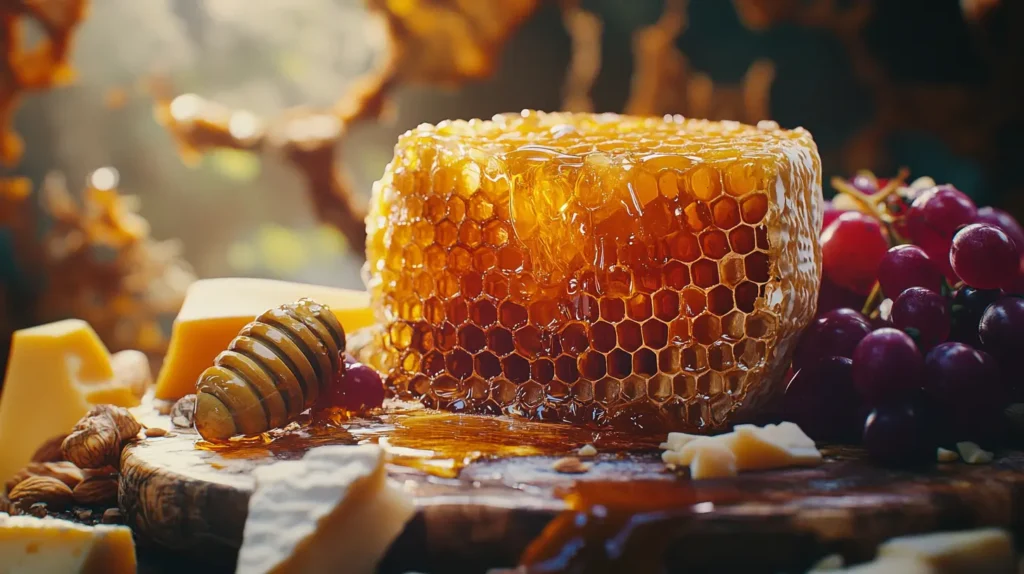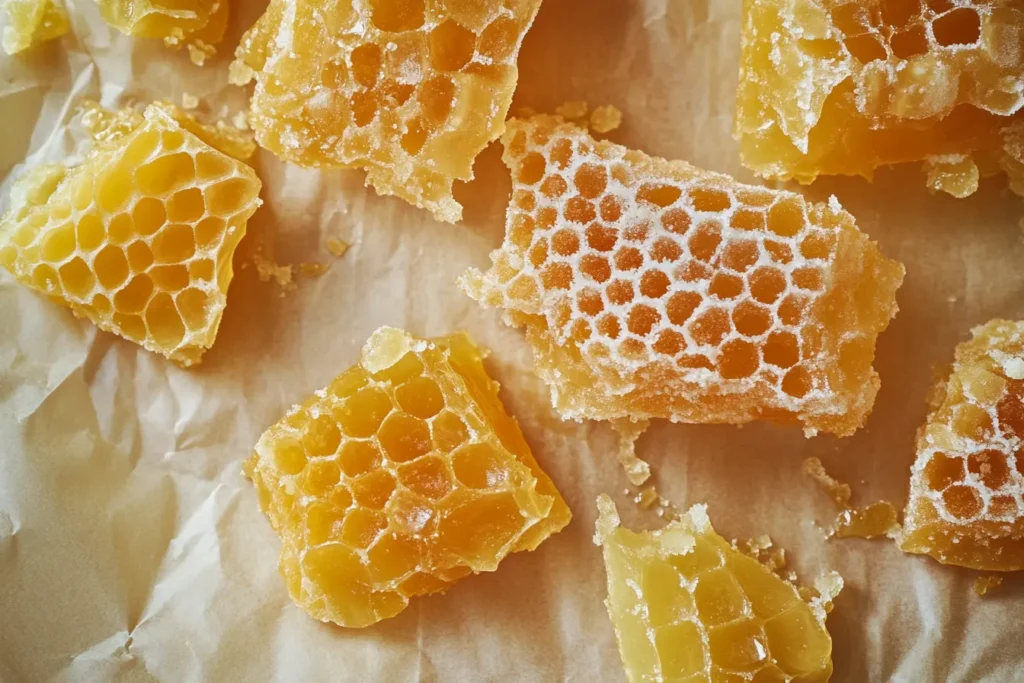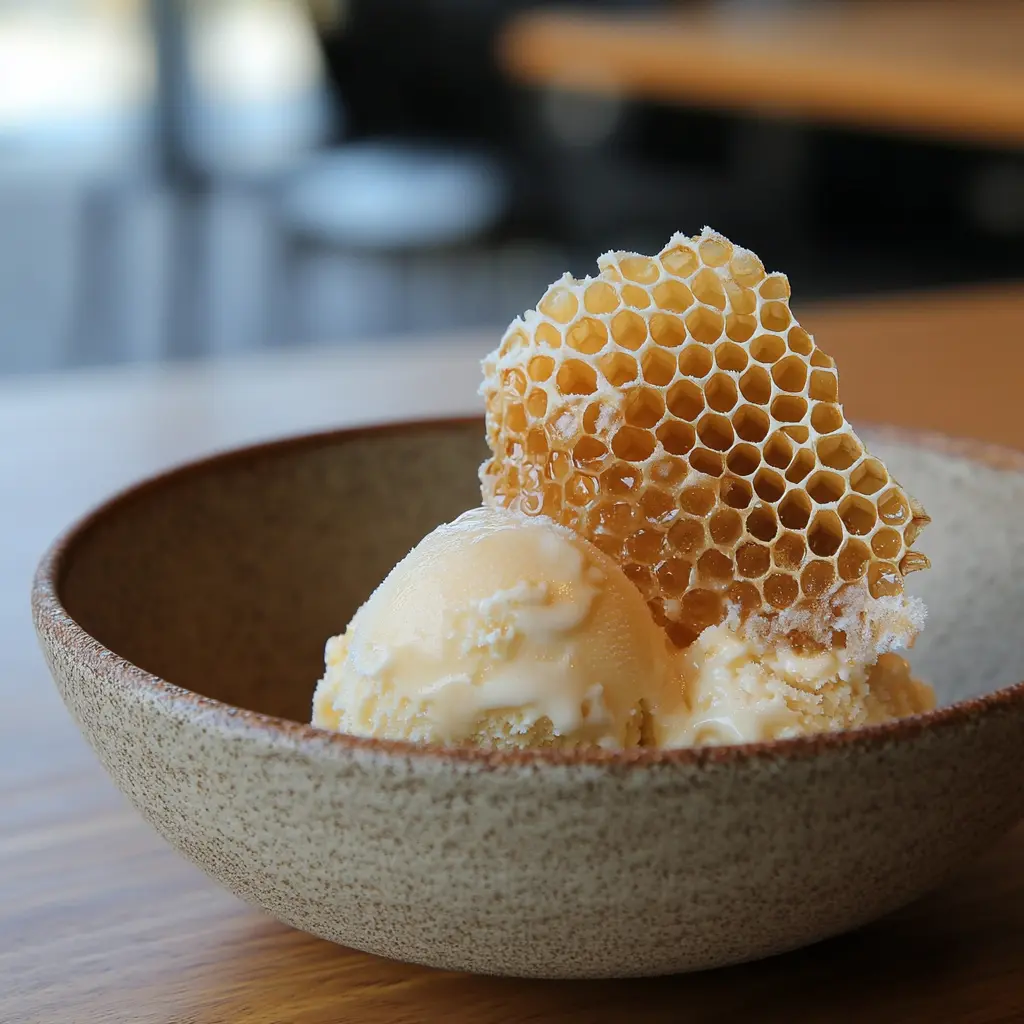Have you ever seen a honeycomb and wondered what it actually is? It’s more than just a pretty pattern! It’s a natural wonder, a feat of bee engineering, and – most importantly for us today – a delicious ingredient. We’re going to dive deep into the world of honeycomb, exploring its structure, flavors, and how we can use it to create some amazing dishes. Get ready for a sweet adventure!
What is Honeycomb? From Hive to Table
Imagine a perfectly organized apartment complex, built by thousands of tiny architects. That’s essentially what a honeycomb is. It’s a structure of hexagonal cells made of beeswax, built by honeybees to store honey and pollen, and to raise their young. Each cell is like a tiny pantry and nursery all rolled into one. Pretty cool, right? 😎
The Structure and Composition of Honeycomb
Honeycomb is a marvel of natural engineering. The hexagonal shape of the cells isn’t random; it’s the most efficient way to fill a space with the least amount of material. Think of it like tiles on a bathroom floor – hexagons fit together perfectly without any gaps. This shape allows bees to store the maximum amount of honey while using the minimum amount of wax. It’s like nature’s own optimization algorithm!
“The hexagon is the most efficient shape for packing circles (or, in this case, the circular cross-sections of the cells) into a plane. This means that the bees use the least amount of wax to store the most amount of honey.” – A simplified explanation of honeycomb geometry.

Honeycomb itself is primarily made of beeswax, a natural wax produced by worker bees. Inside those waxy cells, you’ll find raw honey, which is honey in its purest form, straight from the hive. This honey is unfiltered and unpasteurized, meaning it retains all its natural enzymes, pollen, and antioxidants. It’s like a little package of natural goodness! ✨
Honey vs. Honeycomb: What’s the Difference?
So, what’s the difference between honey and honeycomb? Well, honey is the sweet, golden liquid we all know and love. Honeycomb is the structure that contains that honey. Think of it like this: honey is the juice, and the honeycomb is the juice box. 🥤 The honeycomb adds another dimension – the chewy, waxy texture – which makes for a unique eating experience.
Understanding Different Honey Varieties in Honeycomb
Just like there are different types of honey (clover, wildflower, acacia, etc.), there are also different flavors of honey within the honeycomb, depending on the flowers the bees visited. This means that even within a single piece of honeycomb, you might experience subtle variations in flavor. It’s like a tiny tasting flight of honey!
Honeycomb: A Textural and Flavor Sensation
Eating honeycomb is a multi-sensory experience. It’s not just about the sweetness; it’s about the textures and the way the flavors unfold in your mouth.
The Unique Texture: Chewy, Crunchy, and Melty

The first bite into honeycomb offers a slight resistance as you break through the waxy cells. Then, the honey bursts out, coating your tongue with its sweetness. The beeswax itself is chewy, almost like a natural gum. As you chew, the wax slowly melts in your mouth, leaving a pleasant, slightly sweet aftertaste. It’s a textural rollercoaster! 🎢
A Symphony of Flavors: From Floral to Earthy
The flavor of honeycomb is complex and varies depending on the floral source of the honey. You might encounter floral notes like lavender or clover, fruity hints like citrus or berries, or even deeper, earthier tones. It’s like a snapshot of the local ecosystem captured in a waxy comb. 🏞️
Serving Honeycomb: Presentation and Pairing 🍽️
Honeycomb isn’t just delicious; it’s also visually stunning. Its geometric pattern makes it a fantastic addition to any food presentation.
Plating and Garnishing with Honeycomb
Imagine a cheese board with a glistening piece of honeycomb nestled amongst the cheeses and fruits. It instantly elevates the presentation, adding a touch of natural elegance. You can also use small pieces of honeycomb as a garnish for desserts, salads, or even cocktails. It’s like edible art! 🖼️
Honeycomb Recipes: Pairing with Cheese, Fruits, and More
Honeycomb pairs beautifully with a variety of foods. The sweetness of the honey complements the saltiness of cheese, creating a delightful sweet-and-savory combination. Fresh fruits like apples, pears, and berries also pair well with honeycomb, adding a burst of freshness.
Cheese Boards with Honeycomb
A cheese board with honeycomb is a guaranteed crowd-pleaser. The honey’s sweetness balances the sharpness of cheeses like cheddar or blue cheese. It’s a flavor explosion!
Honeycomb and Fruit Combinations
Try drizzling a little honey from the honeycomb over sliced apples or pears. The combination of textures and flavors is simply divine. It’s like a taste of autumn in every bite! 🍂
Savory Applications and Honeycomb Recipes
Don’t limit yourself to sweet pairings! Honeycomb can also be used in savory dishes. Imagine a piece of grilled chicken glazed with honey from the comb, or crumbled honeycomb sprinkled over a salad with a tangy vinaigrette. It adds a unique touch of sweetness and texture. 🥗🍗
Okay, here’s the second part of the article, continuing from where we left off and aiming for another substantial portion to reach the overall word count goal:
Honeycomb Recipes: A Feast for the Senses
Now that we’ve explored the wonders of honeycomb, let’s get into the fun part: using it in recipes! From simple treats to more elaborate culinary creations, honeycomb can add a touch of magic to your dishes. ✨
Honeycomb Candy: A Simple and Delicious Treat 🍬
One of the easiest and most satisfying ways to enjoy honeycomb is by making honeycomb candy. It’s a simple process that transforms honey into a light, airy, and crunchy treat. It’s like edible air! 💨
Classic Honeycomb Candy Recipes
Here’s a basic recipe for making honeycomb candy:
| Ingredient | Quantity |
|---|---|
| Sugar | 2 cups |
| Honey | ½ cup |
| Water | ½ cup |
| Baking soda | 1 ½ teaspoons |
Instructions:
- Combine sugar, honey, and water in a saucepan over medium heat.
- Stir until the sugar dissolves.
- Bring the mixture to a boil and cook until it reaches 300°F (150°C) on a candy thermometer. This is called the “hard crack” stage. Be careful, hot sugar can cause burns! 🔥
- Remove from heat and quickly stir in the baking soda. The mixture will foam up dramatically, so be prepared!
- Pour the mixture onto a parchment-lined baking sheet and let it cool completely.
- Once cooled, break the honeycomb candy into pieces.
This recipe is super fun to make, and the result is a light, crunchy candy with a deep honey flavor. It’s like a sweet science experiment you can eat!
Variations & recipes : Chocolate Dipped, Flavored Honeycomb
You can get creative with your honeycomb candy by adding different flavors or dipping it in chocolate. Imagine dipping pieces of honeycomb in dark chocolate for a rich and decadent treat. Or, you could add extracts like vanilla or almond to the candy mixture for a unique flavor twist. The possibilities are endless! ♾️
Honeycomb desserts🍨
Honeycomb can be a fantastic addition to various desserts, adding both flavor and texture.

Ice Cream Topping
Crumbling pieces of honeycomb over ice cream is a simple yet delicious way to elevate your dessert. The crunchy honeycomb provides a delightful contrast to the creamy ice cream. It’s like a party in your mouth! 🎉
If you are a fan of homemade frozen treats, check our Ninja creami guide for icecream and sorbet ideas and inspiration.
Honeycomb Crumble for Cakes and Pies 🥧
You can also use crumbled honeycomb as a topping for cakes, pies, or even fruit crumbles. It adds a sweet, crunchy element that complements the other flavors. It’s like adding a little bit of nature’s magic to your baked goods. ✨
Honeycomb recipes for Baked Goods
Incorporating small pieces of honeycomb into baked goods like muffins or cookies can add a unique texture and flavor. The honeycomb will melt slightly during baking, creating pockets of sweetness and a slightly chewy texture. It’s a delightful surprise in every bite! 😋
Honeycomb recipes for Savory Dishes: Beyond the Dessert Plate
Believe it or not, honeycomb isn’t just for sweet treats. It can also be used in savory dishes to add a touch of sweetness and complexity.
Honeycomb Glazed Meats, Recipes
A glaze made with honey from the honeycomb can add a delicious sweetness to meats like chicken, pork, or even lamb. The honey caramelizes during cooking, creating a sticky, flavorful crust. It’s like a culinary masterpiece! 👨🍳
Honeycomb with Roasted Vegetables
Try drizzling a little honey from the honeycomb over roasted vegetables like carrots, Brussels sprouts, or sweet potatoes. The sweetness of the honey complements the earthy flavors of the vegetables. It’s a healthy and delicious way to add some flair to your meals.
Honeycomb in Salads 🥗
Crumbling small pieces of honeycomb over a salad with a tangy vinaigrette can create a delightful balance of sweet and savory flavors. The honeycomb adds a unique texture and a touch of elegance to your salad. It’s like a gourmet salad experience! 🌟
Sourcing and Storing Honeycomb
Now that you’re excited to use honeycomb in your cooking, let’s talk about where to find it and how to store it.
Where to Buy High-Quality Honeycomb
You can usually find honeycomb at farmers’ markets, specialty food stores, or online from reputable beekeepers. When buying honeycomb, look for pieces that are clean, intact, and have a rich golden color. It’s best to buy from local beekeepers if possible, as you’ll be supporting local businesses and getting the freshest product. 🧑🌾
Proper Storage Techniques to Maintain Freshness
To keep your honeycomb fresh, store it in an airtight container at room temperature. Avoid storing it in the refrigerator, as this can cause the honey to crystallize. If the honeycomb does crystallize, you can gently warm it to return it to its liquid state. It’s like giving it a little spa day! 🛀
Honeycomb FAQs: Addressing Common Questions 🤔
Before we wrap things up, let’s address some common questions people have about honeycomb.
Is Honeycomb Safe to Eat?
Yes, honeycomb is generally safe to eat. The beeswax is edible, although it’s not digested in the same way as honey. It passes through your digestive system. However, it’s important to note that infants under one year old should not consume honey or honeycomb due to the risk of botulism, a rare but serious illness. It’s always better to be safe than sorry! 👶🚫
How Long Does Honeycomb Last?
Honeycomb can last for a very long time if stored properly. Because honey is a natural preservative, it helps to keep the honeycomb fresh. When stored in an airtight container at room temperature, honeycomb can last for several months, or even a year. It’s like a time capsule of sweetness! ⏳
Can You Melt Honeycomb?
Yes, you can melt honeycomb, but it’s important to do it gently. Heating it too quickly or at too high a temperature can damage the honey and the beeswax. The best way to melt honeycomb is to place it in a heat-safe bowl over a simmering pot of water (a double boiler). This gentle heat will slowly melt the honeycomb without burning it. It’s like giving it a warm bath! 🛁
For more insights on Food Science and on Honeycomb recipes:
American Honey Producers Association: AHPA (Information about different types of honeycombs)
The Spruce Eats: (Scientific explanation of honeycomb formation)
Conclusion: Embracing the Sweetness of Nature’s
Honeycomb is truly a remarkable natural product. It’s a testament to the incredible work of honeybees, a delicious treat, and a versatile ingredient that can be used in a variety of culinary creations. From its intricate hexagonal structure to its complex flavors and textures, honeycomb offers a unique sensory experience. It’s more than just food; it’s a connection to nature and a reminder of the amazing things that can be created by the natural world. 🌎
By understanding the properties of honeycomb and exploring its culinary potential, we can appreciate it on a deeper level. Whether you’re enjoying it straight from the comb, using it in a recipe, or simply admiring its beauty, honeycomb is a gift from nature that deserves to be celebrated. So go ahead, embrace the sweetness of nature’s candy and let your taste buds embark on a delightful adventure! 🐝🍯✨
